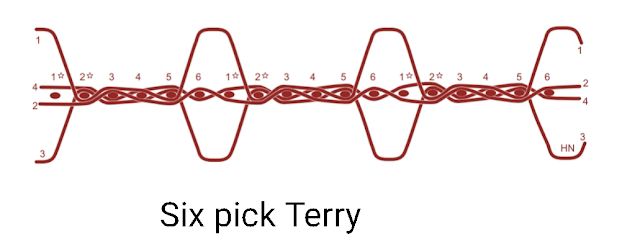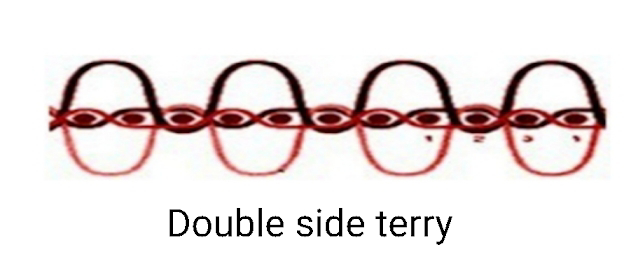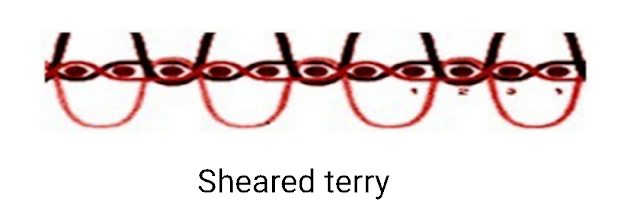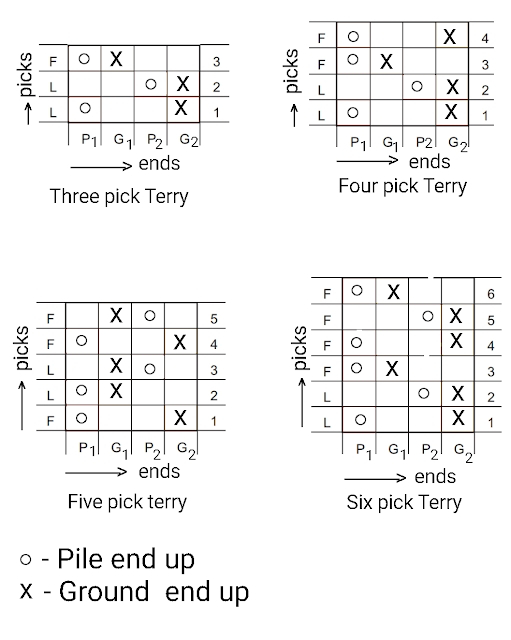TYPES OF TERRY WEAVE :-
Types of Terry Fabric, Construction of Terry Weaves:-
TERRY WEAVES:-
1) This is a special type of weave. This is also known as warp pile fabric.
2) The loops of yarn appear on either a single side or both sides of the fabric.
3)There are two series of warp used to construct this kind of fabric.
4)One series is called the ground warp and the other series is known as pile warp.
5) The loop formation on the fabric surface takes place by this pile warp series.
6) One series of weft yarn is used to weave terry weave.
Loom Specifications:-
a) The terry weave or terry fabric can not be woven on normal looms( the loom which weaves flat fabrics).
b) This weave is woven on the loom having a special mechanical arrangement.
c) There are two independent let-off motion mechanisms mounted on terry looms.
d) The let-off motion gets positively driven.
e)Two different warp beams are used in the terry loom.
f) Terry loom is equipped with either with dobby or jacquard shedding mechanism.
g) A special type of reed is used in this loom. the structure of dents of the reed is designed in such a way that the pile and ground end lie separated in a dent. two rows of dent wire are used in this kind of reed.
h) The loom is equipped with variable reed sweep motion or variable fail of the cloth motion.
I)Since the terry cloth is a heavy fabric so that a suitable take-up roller is used in this kind of machine.
j) The fabric is wound on cloth roll through batching motion in some weaving mills. this batching motion - reduces the doffing time. the piece length is also increased.
Types of Terry Fabrics:-
The terry fabric is classified on different bases. The different bases of terry fabric classifications are given below:
1) According to Weave:
A) Three pick Terry.
B)Four pick terry .
C)Five pick terry .
D) Six pick terry
2) According to loop geometry:
a) Classic terry.
b) Fashion terry.
3) According to loop disposition.
(I) Single side terry.
(ii) Double side terry.
4) According to asurface modification;
1) Sheared terry.
2) Nonsheared terry.
5) According to Use:-
(a) Wash towel.
(b) Hand towel.
(c) Bath towel..
(d) Bathmat.
(f) Beach towel.
(g) Kitchen towel.
(h)Kitchen mitts.
(I) Yoga towel.
(j) Golf towel.
Terry weave construction:-
Ref:-https://www.textileadvisor.com
Terry cloth:-
Terry cloth, terry cotton, terry toweling, terry, terry towel, Turkish toweling (formerly), or simply toweling is a fabric woven with many protruding loops of thread which can absorb large amounts of water. It can be manufactured by weaving or knitting. Terrycloth is woven on special looms that have two beams of longitudinal warp through which the filler or weft is fired laterally.
HISTORY.
Fabrics with a pile formed from loops of loosened, uncut warp threads were woven in ancient Egypt and pre-Columbian Peru; there is linen terrycloth from 4000 BCE. The modern form, however, was introduced to the West in the mid-19th century. The English towel manufacturer English Christy started industrial production in 1850, based on observations of handwoven terrycloth in Turkey. Queen Victoria approved the name "Royal Turkish Towels". In the United States, they became popular after World War I.
The origin of the word is unclear; it may derive from French tiré 'drawn', and was originally used for uncut velvet, called terry pile or terry velvet.
There are two types of terry fabrics:
Towel Terry:-
This is a woven fabric with long loops that can absorb large amounts of water. Its content is usually 100% cotton, but may sometimes contain polyester.
French Terry:-
This is a type of fabric used in clothing. Ranging from items such as hoodies, pants and even shirts. The inside of the fabric is crossed with loops, while the outer part is smooth and flat. It can be 100% cotton or be made from a variety of fibers, sometimes with spandex (also known as elastane or lycra). It is often warp-knitted, and the term French terry is colloquially used for all warp-knitted terry.
It is the length of loops that determines how much fluid is absorbed by the cloth as longer loops provide more surface area to absorb and come in contact with the fluid.
Items that may be made from terrycloth include babies' reusable diapers (or "nappies" in UK-English), towels, bathrobes, bedlinen, and sweatbands for the wrist or head. Terrycloth is also sometimes used to make sweat-jackets. Terry-toweling hats with a shallow brim were once popular with cricketers (like English wicketkeeper Jack Russell), but are no longer in fashion.
A slow method of machine-making French terry results in a soft, sturdy variety called loopwheel. Loopwheel machines can only produce one yard an hour. It was invented in the 1920s and was at the height of its popularity in the forties and fifties, at which point it was overtaken by side-seam manufacturing.
An alternative fabric used for towels is waffle fabric. A modern synthetic alternative is microfiber.
Ref:-https://en.m.wikipedia.org.















Comments
Post a Comment